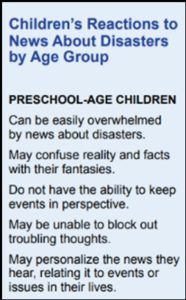 (2018, August) | Useful to Parent Centers, care professionals, and families in understanding and responding to the behaviors they may see in children and youth following a natural disaster.
(2018, August) | Useful to Parent Centers, care professionals, and families in understanding and responding to the behaviors they may see in children and youth following a natural disaster.
While children and youth may experience disaster reactions similar to those of adults, in other ways their experience of disasters is different. Because children and youth may not yet have developed the communication skills needed to seek help in disasters and depend on adults for protection and care, they may be at higher risk for negative mental health and developmental consequences after a disaster such as hurricanes, tornadoes, and earthquakes.
This 20-page edition of the Supplemental Research Bulletin from SAMHSA (Substance Abuse and Mental Health Services Administration) reviews existing literature on behavioral health symptoms in children and youth after natural disasters, including symptoms of depression, anxiety, and post-traumatic stress. It also discusses risk and protective factors that make children more or less vulnerable to the behavioral health effects of disasters. Lastly, it describes a wide range of interventions and methodologies for supporting children and youth after natural disasters, helping to reduce negative mental health outcomes and teaching skills to increase resilience. It’s easy to read, nicely presented, and quite informative.
Access the Supplement at:
https://www.samhsa.gov/sites/default/files/srb-childrenyouth-8-22-18.pdf

